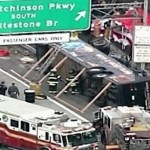NTSB Blames Driver Fatigue for Fatal Bus Crash
In an investigation that’s lasted over a year, and one we blogged about just last month, the National Transportation Safety Board released its findings in a final hearing last week, pointing to driver fatigue and speed as the causes in a New York bus crash that ultimately killed 15 people.
The bus accident occurred in March 2011 as a bus carrying 32 people was heading towards Manhattan from a trip to the Mohegan Sun casino in Connecticut. It was before dawn when the bus hit a guardrail, rolled on its side and slid into a large sign post, shearing off the top of the bus and killing several people instantly.
In all, 15 were killed and 7 were seriously injured. Continue reading
In Brooklyn-Queens Expressway Fatal Bus Accident, Driver & Company Had Prior Safety Problems
Investigative documents were released last week in the case of the Brooklyn-Queens Expressway bus accident last year that killed 15 people and injured several others. According to the documents, as reported by Bloomberg Businessweek, this wasn’t the first problem for the bus company or the driver.
The accident occurred on March 12, 2011 as a bus full of passengers was returning from the Mohegan Sun casino in Connecticut. The bus flipped on the Expressway, hitting a post which sheared off the roof of the bus.
According to initial investigations, the driver said that a tractor-trailer veered into his lane and ran the bus off the road. But investigators said they couldn’t find any evidence of this claim.
The National Transportation Safety Board found in their investigation that the driver had his license suspended 18 times in past years and had been fired from two previous transportation jobs. At the time of the accident, he was shuttling passengers to and from casinos multiple times daily, catching sleep when he could. On the morning of the tragic accident, he reportedly slept on the bus from midnight to about 3:20 a.m.
The company behind the bus was given an “unsatisfactory” rating by the U.S. Federal Motor Carrier Safety Administration after the accident and has since shut down. Continue reading
New York Buses Will Undergo More Frequent/Thorough Inspections
 New York buses can expect to be under greater scrutiny in the state’s effort to prevent deadly accidents like those seen in 2011. The state has earmarked $1 million for a new bus inspection program, according to LoHud.com. The new program will force some buses to face multiple inspections per year, based on prior performance and a number of other factors.
New York buses can expect to be under greater scrutiny in the state’s effort to prevent deadly accidents like those seen in 2011. The state has earmarked $1 million for a new bus inspection program, according to LoHud.com. The new program will force some buses to face multiple inspections per year, based on prior performance and a number of other factors.
The companies who have failed inspections or who have bad safety records will see more inspections than those who do well. All companies will get at least two inspections per year, which is the current standard.
In 2011, there were two major bus accidents in the state, one which killed 15 in March and one that killed 8 in October.
In the March 2011 crash, the driver was found to have hit near 80 miles per hour prior to the crash, and to have convictions for manslaughter and grand larceny on his record. In that accident, the bus tipped on its side and slid, allowing a pole to rip through the roof and the length of the bus. Continue reading
New developments in New York City bus accident that left 15 dead
On the one-year anniversary of the New York City bus crash that left 15 people dead and injured 18 others, the National Transportation Safety Board (NTSB) announced that it will meet on June 5 to determine the probable cause of the crash. Although the NTSB investigation into the bus accident is still in its final stages, early speculation about alcohol or drug use by the bus driver as a possible cause for the tragedy appears to have been without merit.
In addition to the driver’s negative toxicology test results for drugs and alcohol, NTSB investigators have also found no mechanical problems that would have prevented the driver from safely operating the tour bus prior to or during the crash sequence. The list of potential causes board members will be evaluating at the June 5 meeting includes driver error, highway surface or design defects, non-mechanical vehicle factors and motor carrier oversight failures. Continue reading